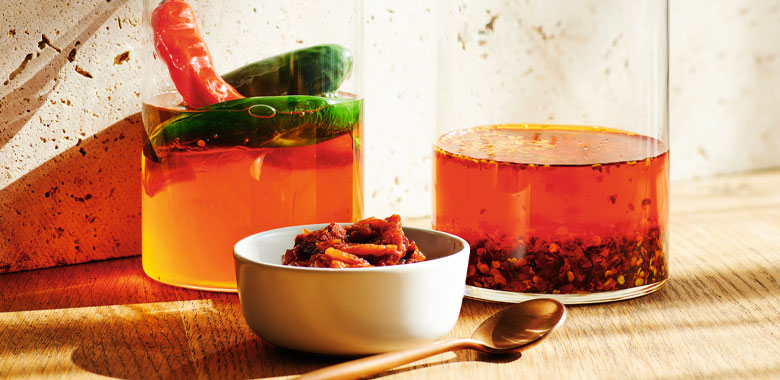
Food
Seasonal Chillies
Chillies were brought to the world at a time when stories and ideas travelled with bolts of silk and sacks of nutmeg, cinnamon and cloves. From the Middle Ages through to the Renaissance, culture and commerce travelled on the spice route – across deserts and oceans in boats, caravans and on camels’ backs – from the far east to the merchants of Venice. It was a time when the humble peppercorn was king.
When the Ottoman Turks blocked access to Europe, Christopher Columbus set off in search of another route to Asia and to those precious peppercorns. On reaching the Caribbean, Columbus instead discovered potatoes, tomatoes and a rainbow of capsicum – ranging not just in colour but in piquancy. He called them peppers for their similarity to the other berry that had taken the world by storm. Perhaps it was also one of the earliest and greatest acts of marketing.
It was indeed a clever ploy. In the 15th Century, the Portuguese traders introduced the chilli “pepper” to Asia. Interestingly it would be at this extremity, perhaps more than the European countries in between, that the chilli was going to rise to ascendency. To imagine Thailand without nam jim, the Koreans without a kick in their kimchi or the Sichuanese without the heat in their ma po tofu would be to reimagine their cuisine altogether.
THE FIRE WITHIN
An anomaly among the building blocks of the culinary world (the sweet, sour, salty, bitter and umami), chilli is more likely to be compared to ginger and horseradish than its nightshade cousins – all foods that emit heat or spiciness in the mouth, a pungency, which is the scientific description used to avoid the ambiguity of words such as hot or spicy.
And yet, when you look at these (particularly) Asian cuisines, the addition of chilli has forced a different balance on their cuisine: salt, sour, sweet and pungent (spicy).
In the chilli, this heat comes from capsaicin and capsaicinoids; a factor most commonly measured in Scoville heat units (SHU), invented by American pharmacist Wilbur Scoville in 1912. The pungency is conveyed to the brain by sensory fibres in the mouth (as opposed to taste buds).
These fibres can also be found in parts of the body with no taste receptors, such as the nasal passage, open wounds and the nether regions, which is why you want to take great care to wash your hands thoroughly after coming in contact with chilli!
Chillies and their capsicum brothers originated in Bolivia and are thought to be first cultivated in Mexico. There are five domesticated species of chilli peppers, each playing host to numerous sub-species ranging from the harmless bell peppers (0 SHU) to jalapeños (3,500–7,000 SHU), cayenne (30,000– 50,000 SHU) and the Scotch bonnet (100,000–350,000 SHU), among the hottest of them all.
While not quite as ubiquitous as the pepper grinder, chilli has also found its way into common condiments worldwide: from bottles of tabasco and piri piri, to cayenne pepper and paprika, smoked and otherwise.
THE EXTENDED FAMILY
Beyond the pungent recipes, we would be remiss not to discuss their milder cousins. It is here they are perhaps most at home in the European middle ground: the Spanish Romesco sauce (made with tomatoes and capsicum), the Italian peperonata (slowly cooked with onion and occasionally spiked with vinegar and capers) and the Turkish Muhammara (a spicy dip made with the addition of walnuts and pomegranate molasses) are a few among a list of many!
Particularly lovely roasted to charred and unburdened of their skins, they become soft and sweet, a mild addition to any cuisine.
While the vibrant chilli “pepper” has been happily adopted the world over, there are no culinary traditions that rival their homeland. In Mexico, they still cultivate up to 150 different varieties of chilli, each carefully selected, not just for their pungency but also for their smokiness, sweetness, fruitiness or earthy tones.
The Aztecs even combined them with chocolate (a combination well worth trying). Of course, there’s still a lot for us to learn about this beautiful fruit that stretches beyond the pungent, and while it’s not quite the caravans and camels of the spice route, it’s an adventure nonetheless.
Select and Store
Removing the seeds helps decrease the heat of the chilli. When buying fresh chillies, look for bright green stems and firm, unblemished skin. To make chilli oil, dry the chillies out (we string them over a fire, but anywhere with limited humidity is fine) before adding to the oil – moisture in the chilli can cause the oil to become rancid. It's always worth tasting a tip of chilli before adding it to your dish, to be sure of the pungency and thus dosage.